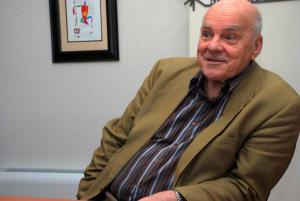A man of unique experience
The day Paul-Henri Rebut joined the recently-created Fusion Department at CEA, most offices and labs were deserted. It was September 1958, and everyone was in Geneva attending the second Atoms for Peace Conference where, among other momentous decisions, fusion research was to be declassified.
This was the last time an important chapter of fusion history was being written without Rebut having a hand in it. The young graduate of the prestigious École Polytechnique would soon be making pioneering contributions to plasma physics, and, for the 40 years to follow, to the design and engineering of ever-more-powerful fusion machines. TFR, the French tokamak that dominated magnetic fusion in the mid-1970s; JET, the first machine to achieve deuterium-tritium fusion in 1991; the early ITER design ... all bear witness to his vision and creativity.
"Paul-Henri Rebut," read his commendation at the award of the European Physical Society prize in 2006, "is one of the most successful physicists, engineers, machine-builders and managers in the history of magnetic confinement fusion."
"When I began my career," says the 73 year old physicist, now a regular consultant for the ITER Organization, "discharges in our rudimentary fusion machines lasted at best one millisecond, and plasma temperatures were in the 100,000 °C range. Still, I was certain that, one day, fusion's contribution to our energy needs would be essential."
The JET experiments from 1991 to 1997, during which 16 MW of peak fusion power was released, had convinced Rebut that the "next machine" should aim for ignition—the self-burning of the plasma without auxiliary heating systems. Under his direction from 1992 to 1994, ITER aimed at just that. But gathering political support for a project of that scope and ambition proved impossible.
ITER had to settle for less, which, in Rebut's opinion "was a mistake of historical dimension. We lost 30 years in our quest for fusion."
Fifteen years have passed since Paul-Henri Rebut left the ITER Project, but he is still a familiar figure at ITER Headquarters and the other buildings of the Organization. "Rebut's experience is unique," says the ITER Principal Deputy Director-General Norbert Holtkamp. "As a consultant, his contribution has been exceptionally creative."
The former director of TFR, JET and ITER has some very personal ideas on the future of fusion—ideas, he warns with a mischievous smile, "that are not what one would consider as politically correct."
Rebut's main objective has not changed: "We have to make ITER work, that's the absolute priority." In his view however, the project could open a whole new perspective for fusion. "With ITER, we will have proved that we can harness a plasma and produce a steady stream of highly energetic neutrons. Now, the interesting question is: Can we find a better use for these neutrons?"
"In a pure fusion reactor," he explains, "the 14 MeV neutrons are slowed down in the blanket to produce heat, but they are not used to their full potential. Another solution is to take advantage of their considerable energy to induce fission reactions in a blanket that would include some fission fuel, like natural uranium (U 238) or thorium. By doing this, the energy produced could be multiplied by a factor 10 ... This is what the 'hybrid reactor' is about."
But whatever the future of fusion, be it "pure" or "hybrid," it relies on the success of ITER—a possible hybrid reactor will depend on a fusion furnace to produce the fission-inducing neutrons.
At 73, the legendary builder of TFR and JET, the designer of the original "Big ITER" acknowledges he has "always been at odds with the trends of the time." And he is always ready to lend a hand in writing yet another chapter in the long history of fusion.


